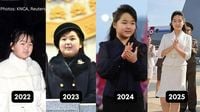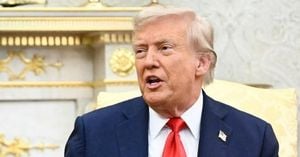In a country where secrecy is the norm and dynastic rule has shaped its history, a new face is emerging at the forefront of North Korea’s tightly controlled public sphere. Kim Ju-ae, believed to be just 12 or 13 years old, has transformed from a rarely seen child into a prominent—and perhaps pivotal—figure alongside her father, Supreme Leader Kim Jong-un. Her growing visibility, especially in military and diplomatic settings, has sparked intense speculation both inside and outside the isolated nation: Is North Korea preparing its first female leader?
Kim Ju-ae’s public debut was anything but ordinary. According to The New York Times, she was introduced to the world in November 2022, standing hand-in-hand with her father in front of an intercontinental ballistic missile. The symbolism was unmistakable—a show of both affection and power, set against the backdrop of North Korea’s military might. Since then, state media has featured her more and more prominently, often referring to her in reverent terms such as “the most beloved,” “respected,” or “dear” daughter of the Supreme Leader. Yet, she holds no official title, and the outside world has never heard her speak.
Despite her lack of formal status, Kim Ju-ae’s presence at key events is impossible to overlook. She has attended military parades, state banquets, and missile tests, and has even received foreign dignitaries alongside her father. In February 2023, she was seen at a banquet celebrating the 75th anniversary of the Korean People’s Army, followed by her participation in a grand military parade. By March 2024, she appeared in a more active military role, posing with binoculars and exuding a newfound confidence. Footage from October 2024 captured Kim Jong-un nudging her forward to greet the Russian Ambassador—a subtle but significant gesture, signaling her growing role in North Korea’s diplomatic engagements. Most recently, in June 2025, she was seen once again receiving foreign dignitaries with her father, further cementing her public status.
Analysts and intelligence officials are paying close attention. South Korean intelligence believes Kim Jong-un has two, possibly three, children, but only Ju-ae has made public appearances. Her emergence is viewed by many as a calculated move to establish her as the next in line, despite the deeply patriarchal nature of North Korean society. As Korea Herald and Times Now News report, experts see the repeated exposure of Ju-ae in state media as an effort by Kim Jong-un to make her status as successor a fait accompli.
“In North Korea, where officials and people are not ready to accept a female leader, Kim Jong-un is making his daughter’s successor status a fait accompli by repeatedly exposing her through state media,” Cheong Seong-chang, an analyst at the Sejong Institute in Seoul, told The New York Times. This sentiment is echoed by Donald Southerton, author of “Korea 101,” who observed, “The child who first appeared as a family curiosity is now a polished, rehearsed figure woven into North Korea’s ongoing story of dynastic power. Each photo, parade walk and salute I see as a carefully staged story of succession, legitimacy and continuity for the Kim dynasty.”
The transformation of Kim Ju-ae’s public image has been striking. Her early appearances showed her as a shy girl in a padded white jacket, standing behind her mother as her father addressed military officials. Over time, she has moved to the front row, now donning tailored leather coats, fur collars, and designer suits—outfits that project authority and sophistication. Her mother, Ri Sol-ju, has receded from the spotlight, seemingly to allow Ju-ae to take center stage. Observers note that even her posture, gestures, and expressions have evolved, reflecting a carefully curated persona befitting a future leader.
The orchestration of Ju-ae’s rise has extended beyond public appearances. In a telling moment at a 2023 military parade, a top general was seen kneeling before her—a gesture of deference previously reserved only for Kim Jong-un himself. Such displays of loyalty from senior military officers are significant in a country where the military is central to power. North Korea has even issued postage stamps featuring images of Kim Jong-un and his daughter, further embedding her image into the nation’s iconography.
Despite the growing anticipation, Kim Ju-ae remains an enigma in many ways. She has no known official title, and state media has never broadcast her voice. Her age is estimated to be 12 or 13, with her birth year believed to be either 2011 or 2012. The deliberate ambiguity surrounding her personal details only adds to the intrigue. While Kim Jong-un is still relatively young—about 41 years old, according to South Korean intelligence—his family’s history of heart trouble and his own unhealthy habits, including chain-smoking, heavy wining and dining, and late-night internet sessions, have prompted speculation about the urgency of establishing a clear successor.
The stakes are high. If Ju-ae is indeed being groomed to lead, she would become the first woman to rule North Korea’s highly militarized and secretive regime, as well as the world’s newest nuclear power. This would mark a dramatic shift in a society where leadership has long been passed from father to son. The calculated nature of her appearances—especially at military and diplomatic events—suggests a deliberate effort to acclimate both the North Korean elite and the general public to the idea of a female successor.
Yet, nothing is certain in North Korea’s opaque political landscape. While experts and analysts see clear signs of succession planning, the regime’s inner workings remain shrouded in mystery. The world has seen heirs apparent rise and fall before in authoritarian dynasties. Still, the frequency and symbolism of Kim Ju-ae’s appearances, coupled with the orchestrated displays of loyalty from the military, point to a regime intent on preserving dynastic continuity—potentially with a groundbreaking twist.
As North Korea continues to project Ju-ae’s image at home and abroad, the international community watches closely. Her transformation from a background figure to a poised, authoritative presence is more than a family affair; it’s a signal that the Kim dynasty is preparing for its next chapter. Whether Ju-ae ultimately ascends to power remains to be seen, but her story is already reshaping the narrative of one of the world’s most secretive regimes.




